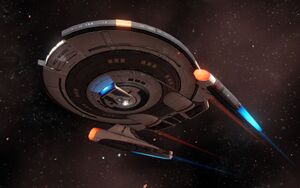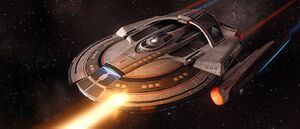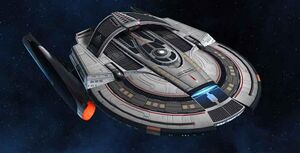Reliant Class
More actions
The Reliant-class frigate is a modern, capable starship intended to handle routine border and spacelane patrol duties. A successor in appearance and role to the venerable Miranda-class frigate, the Reliant has been in wide-spread production since the early 2390s. While the Miranda was only designated a frigate in the 2360s towards the end of her lifespan, the Reliant was designed from the ground up with this role in mind. The goal of this design program was to provide a small, versatile starship that could be built quickly and easily at facilities all around the Federation to supplement Starfleet's inventory of light cruisers and escorts, which had grown significantly in both size and complexity over the 24th century.
Exploration and Science
Though not designed to embark on long-range, independent exploration missions, Reliant is still a capable scientific platform for missions such as planetary surveys. Uniquely for a ship of her size, Reliant does not have any specialized labs–all six of her science labs are generalized and configurable to the particular mission she has been assigned to, rather than having dedicated spaces for each discipline. To save space, there is no stellar cartography bay, but there is an astrometrics suite that serves the same function.
Reliant has enhanced long-range sensors mounted in two pods between the superstructure and the primary hull, which give her above-average range and precision in terms of scanning ability, which makes her ideal to patrol the Federation’s borders.
Diplomacy
Not well-suited to diplomatic missions above the level of simple two-party negotiations, Reliant is nevertheless equipped with several guest suites that can be configured to different environment types. More often than actually hosting negotiations herself, Reliant is tasked with delivering diplomats or senior Starfleet officers to conferences within Federation space.
Engineering
As with her predecessor, Reliant dispenses with a full secondary hull and instead has her engineering sections integrated into a superstructure attached directly to the ship’s saucer section. This gives the ship a sleek profile and minimizes construction costs. The primary hull contains most of the ship’s crew quarters, science labs, and command facilities, while the superstructure contains power generation systems, the ship’s twin shuttle bays, an extensive cargo management area, and the impulse engines.
An obvious visual difference between Reliant and Miranda is that Reliant is equipped with a medium-sized main deflector on the ventral side of her saucer section and a smaller secondary deflector under the ship’s main bridge. These two deflectors both extend the ship’s long-range sensor range and provide the necessary deflector power for the newer vessel’s much-improved top speed. Otherwise, the dimensions between the two classes are mainly unchanged, apart from a small increase in overall length and width, and a decrease in height due to the larger nacelles being positioned at a slightly wider angle from the main hull in Reliant than in Miranda.

Reliant’s propulsion systems were designed to improve the overall cruising speed to a very respectable Warp 8, but limits her overall top speed to Warp 9.5, both to minimize the complexity of her engines and to extend their lifespan. Based on a scaled-down version of the same warp coils in use aboard the Sovereign-class, Reliant is theoretically capable of sustaining higher speeds with the addition of a larger power plant, but her mission profiles would rarely call for this sort of modification. In short, Reliant is designed to be dependably quick, but not to be any kind of great sprinter.
The ship’s impulse engines are similarly designed to prioritize an overall above-average performance with reduced maintenance and higher reliability, versus all-out extreme performance. This is a new model of impulse engine based on the original ship’s combination warp-impulse power plant, which is able to draw directly from the ship’s primary warp power conduits as needed. Compared to her mother class, Reliant has had her impulse engines relocated from the ship’s centerline to positions flanking the shuttle bays, in line with the warp nacelle pylons. This has the added benefit of being able to use impulse thrust to control the ship’s heading to a greater degree than was previously possible, which further increases Reliant’s efficiency.
Small craft facilities aboard Reliant are oversized for a vessel of her size, with identical twin shuttle bays on the aft end of the ship’s superstructure flanking the ship’s centerline taking up a large portion of three decks. Between these shuttle bays is a large cargo hold, which makes Reliant suited to colony support and cargo transport missions. While only normally equipped with four shuttles and four workbees, Reliant could easily handle up to twenty shuttles, or a half-dozen runabouts on a short-term basis as mission needs dictate.
Computer and navigation systems are provided by a computer core that runs from the floor of the main bridge to the top of the ventral sensor dome. This computer core is primarily isolinear, though it does have banks of bioneural processors that can be tasked with specific functions. For instance, this additional power could be devoted to the science labs during a stellar survey or to the holographic projectors when multiple EMH instances are needed for a casualty situation.
Tactical

Equipped with eleven small Type-XII phaser arrays, Reliant is provided with all-around beam weapon coverage, which is a major improvement over Miranda, which had several well-known blind-spots. Like with her engines, Reliant’s phaser arrays are an adapted version of the same arrays in use aboard Sovereign, which are a substantial improvement from earlier phaser arrays in terms of their precision and combat survivability, though with Reliant’s smaller power generation ability and thus lower firepower, they are expected to last at least twice as long as their larger cousins before needing major maintenance. Theoretically, it would be possible to achieve greater performance with these arrays with additional power.
Torpedo coverage is provided by a pod located above the main superstructure of the vessel, which contains two forward and two aft torpedo launchers, each capable of firing in volleys of up to three torpedoes at once. Ordnance is stored in this pod, as well, and typically they carry a mix of photon and quantum torpedoes.
In addition to ten centimeters of ablative armor on her hull, Reliant is equipped with the same multi-layer shielding system found on similar ships of her size and mission, with an estimated 120% greater survivability than modernized Miranda-class ships experienced during the Dominion War. Crew survivability is further increased by having 58 nine-person ASRV-type escape pods and EMH coverage throughout the entire ship.
Substantially better-armed than the older Steamrunner, Norway, and Saber-class ships from the 2360s and 2370s, this ship is ideal for patrol missions where light combat is anticipated. In more dangerous areas, Reliant-class ships operate in pairs or trios, and are quite capable of handling pirate and raider threats.
Shipboard Life

Due to modern automation, Reliant has approximately twenty fewer crewmembers than Miranda, but due to the shrinking of certain internal systems, she also has a far greater standard of living than that small difference in crew size might suggest, with two full holodecks, four smaller holosuites, and a full range of permanent recreational facilities. Accommodation standards are similar to the Intrepid-class, with no greater than double berths for even the most junior crewmembers. In a pinch, though, the ship’s life support systems could support a crew of up to 500, with the addition of bunk beds. The ship’s evacuation capacity is an impressive 750, though this would only be possible with the conversion of the shuttle bays and cargo holds into living areas.
Assignments to Reliant-class ships are seen as preferable to many of the other ships of her size, given her high standards of accommodation. Reliant captains and crews tend to be either relatively junior or people who have purposefully selected assignments that would keep them in or near Federation space.
Overall, the Reliant is designed to be a capable, dependable workhorse starship that can handle nearly any mission with relative crew comfort and without Starfleet needing to invest in a more powerful or more specialized asset, all while flying the familiar silhouette of Miranda, a starship which has become an iconic symbol of Starfleet.
Class History
By 2353, there were over 2,000 Miranda-class starships in service. Originally designated as light cruisers but reclassified in the 2350s, these reliable frigates had been in mass production since the 2270s and had largely supplanted their Constitution-class cousins within the first two decades of their service due to being better armed, more efficiently shielded, and, generally speaking, a more sensible combination of facilities needed for Starfleet’s quotidian missions. For her form factor, there were few other true replacements available for much of the eighty years she was in wide service, though many other medium-sized ships were also developed then, including the Renaissance, Soyuz, and Centaur-types. While Constellation-class heavy cruisers were able to carve out a niche for themselves between the Miranda and Excelsior, Starfleet’s trend towards larger and larger ships had left a gap on the lower end of the spectrum long enough that its mainstay frigate had gone decades and decades without substantial upgrades.
A fleet modernization program with the Galaxy and Nebula-class explorers at its core was envisioned as early as the 2340s, along with an assortment of smaller ships that would replace the Miranda-class not writ large but with specific starships optimized for specialized roles. This started with the Cheyenne, Springfield, and Challenger classes being introduced as fast cruisers, science vessels, and light cruisers respectively in the early 2350s, before the more advanced New Orleans-class frigates came into service in the early 2360s just ahead of their larger cousins. Slowly, as these new units came online, Miranda-class ships were retired and mothballed or transferred to colonial defense fleets until 90% of these vessels were out of service by 2365. The remaining units continued on as transports, couriers, and training vessels for most of the rest of that decade, being further sidelined by the Norway, Steamrunner, Saber, and Akira-classes which were beginning to enter service.
With war with the Dominion looming, Starfleet began to realize that it had a problem: Miranda-class ships were not being replaced one-for-one. A New Orleans-class ship typically took four Mirandas out of service, for example. An Akira was “worth” six, based on overall mission capabilities. For large fleet engagements, numbers were as useful as sheer power, and so Starfleet began to quickly rearm and redeploy its Miranda fleet in stripped-down capacities, most of them without their science facilities reactivated, to bolster the fleet. This proved fortuitous as they became the most common screening ship during the largest battles of the Dominion War, suffering huge losses themselves but allowing much larger ships like the Galaxy and Nebula to operate with minimal losses.
At the end of the Dominion War, however, these ships were returned to the mothball yards as quickly as they could be replaced and by 2385 the last Miranda-class vessel was decommissioned for the final time. Starfleet continued to develop more and more vessel classes, all with their own specializations. The Excelsior-class, once the flagship of the fleet, had slowly settled into its role as a workhorse, though fewer and fewer of them remained in service by the end of the 2380s and sending in a crew of 750 to most missions was simply overkill.
Fleet diversity reached its apex in the 2380s, with all of the specialized small vessels produced in the 2350s through 2370s still in service across the fleet, which made deciding which ships to position where extremely complex, as their capabilities were so diverse. While the Aquarius-class was successful in its narrow niche of, it was not large enough to handle significant secondary humanitarian or scientific assignments. California and Parliament-class ships were ubiquitous, but completely unsuited to combat missions, with their relatively large crews and light armaments being liabilities should they come under attack. In terms of a generalist patrol vessel, Starfleet found itself missing the versatility of the Miranda-class, and the basic spaceframe design was still quite sound.
Thus, the Reliant project was born. The brief was simple: a modern replacement for the Miranda-class that could handle missions within and near Federation space of short to moderate duration, with a minimum of fuss. The obvious starting point was the Miranda design itself. Due to the age of the hulls and the long-term effects of baryon radiation on their space frames, it was not possible to simply refit the fleet to modern standards, so a new design was needed. To expedite the design process, the ADSB was given strict orders not to reinvent the wheel: Starfleet Command wanted and needed a modern Miranda and that’s what they were going to get.
Design cues were taken from modern, successful starship designs. Still rare and powerful in the 2380s, the Sovereign-class ended up lending many of her systems to the humble Reliant, though scaled-down and lower-power. The Reliant didn’t have any peaks on its performance ratings–it was fast, but not too fast. It was well-armed but not a warship. It broke no records when it came to scientific or medical facilities, but was rated at being able to handle 80% of all mission profiles. She was the epitome of the “go anywhere, do anything” school of design. Due to using advanced but highly-tested components at a lower power level, Reliant was expected to be a good use of construction and maintenance resources.
A solid, stable design, the ADSB was also mindful in creating Reliant of the lessons of the Dominion War, in which her Miranda predecessor were pressed into service as warships. Space was purposefully left within the hull for a larger power plant to be installed if need be, which would raise the ship’s performance to the design potential of her components. Starfleet’s new fleet of reliable general-purpose vessels would be able to be quickly and effectively refit into powerful, compact warships or long-range explorers as future needs dictate.
More than thrilled with the new design, Starfleet gave a shocking initial order of 1,000 units, the largest single order of starships in the history of the Federation, assigning construction contracts to more than two dozen yards across the Federation, pending the completion of the prototype unit. They would begin to replace the hodge-podge of medium-sized ships produced in the 2340s and 2350s, raising overall fleet capabilities, while also smoothing out disparities between different fleet units.
Reliant herself began construction at the Beta Antares shipyards in 2387 and was launched in 2389. Large-scale production began after her initial spaceworthiness trials. As of the early 25th century, there are several hundred in service, which has allowed Starfleet to start decommissioning the oldest of the other ships in her size class.
In Play
- Significantly smaller than the California and Parliament classes, the Reliant is meant for patrol missions, with other assignments being secondary tasks. For instance, in between patrol shifts, she might handle a scientific survey or transport mission, but she doesn't have the space or the crew size to handle bigger tasks.
- Meant to be ubiquitous and highly useful, without being over-powered or ultra-modern, the Reliant-class would commonly be encountered in Federation space after 2389. She is the perfect NPC supply ship, transport, patrol vessel, etc. because of her well-roundedness.
- Reliant-class ships make a good starter ship, either for a junior command character or an inexperienced game master, because their niche is not really having a particular niche; they're okay at everything without being great at any one thing, which also means that they don't have any major weaknesses like certain more specialized classes might.
- Reliant-class ships also make good transports for flag officers, given that they're fast but don't use many resources. They would not be suited for an Admiral leading from the front--in that case, they'd want an ''actual'' flagship like an Odyssey or a Sovereign--but they're unobtrusive enough and well-defended enough to be an admiral's day-to-day transport within Federation space. They're also less likely to critical missions like larger ships.
- Reliant-class crews are made up of officers fresh out of the academy and others with junior standing; this is the place you learn the ropes, not a prestige assignment.
